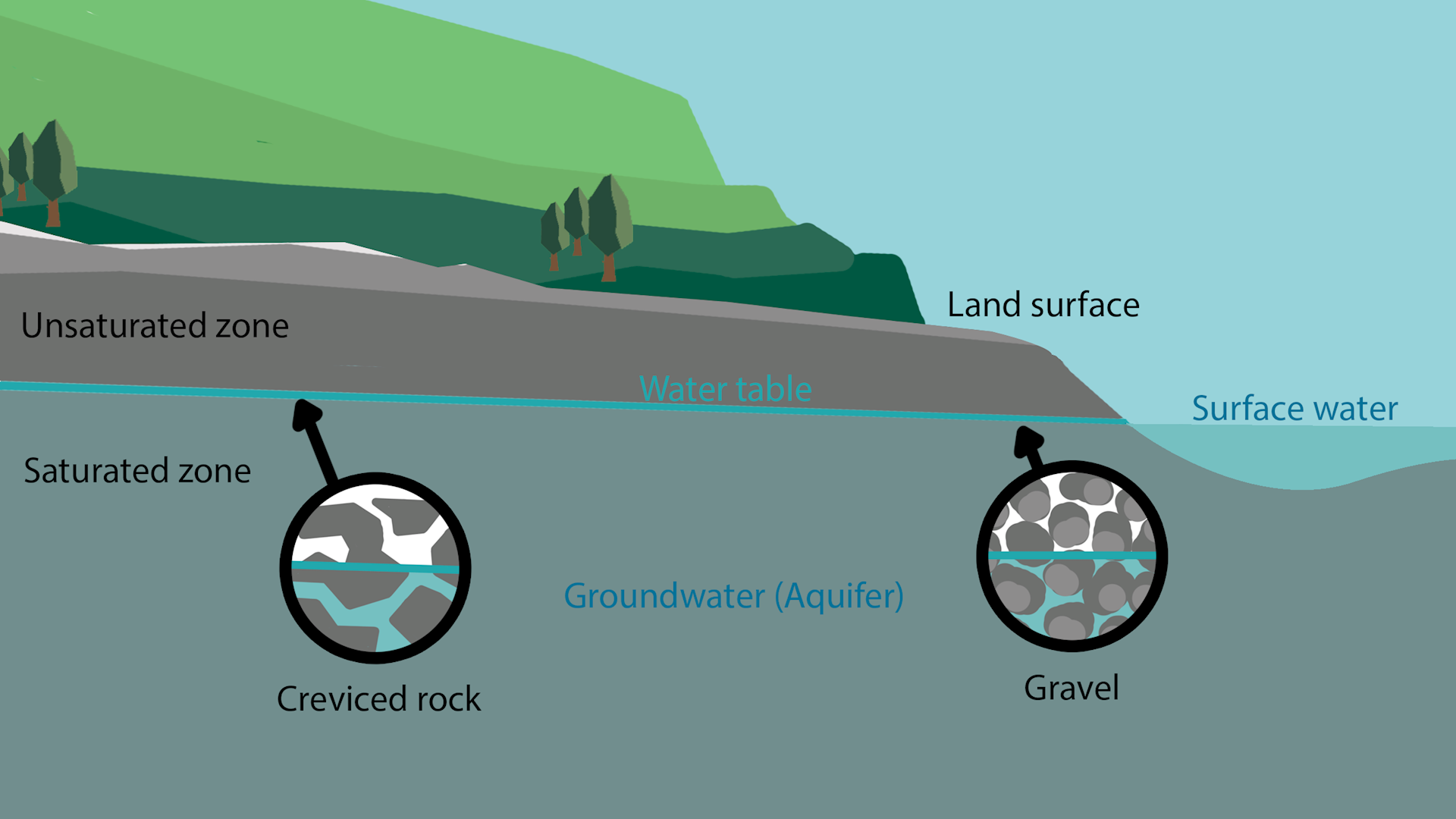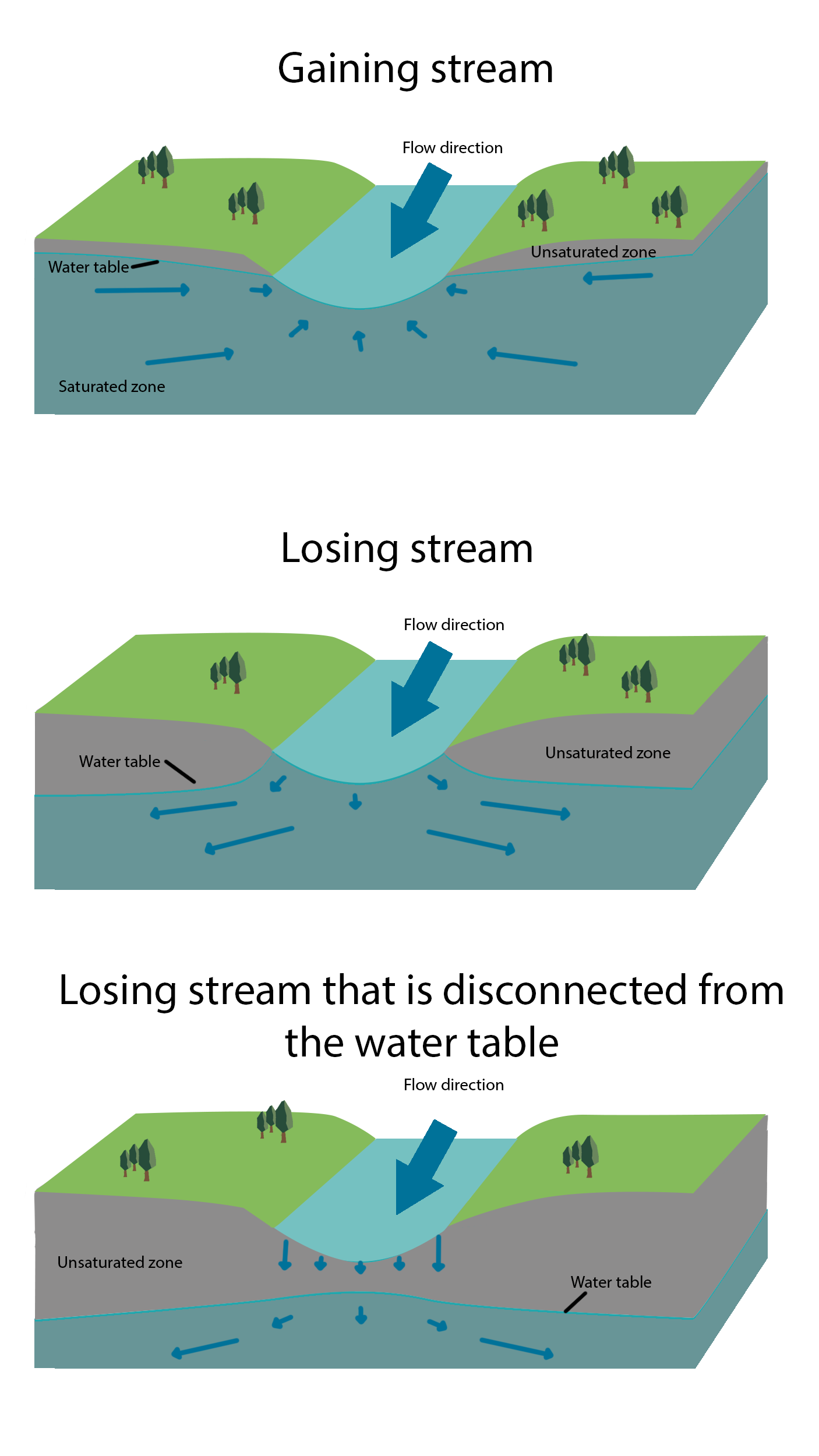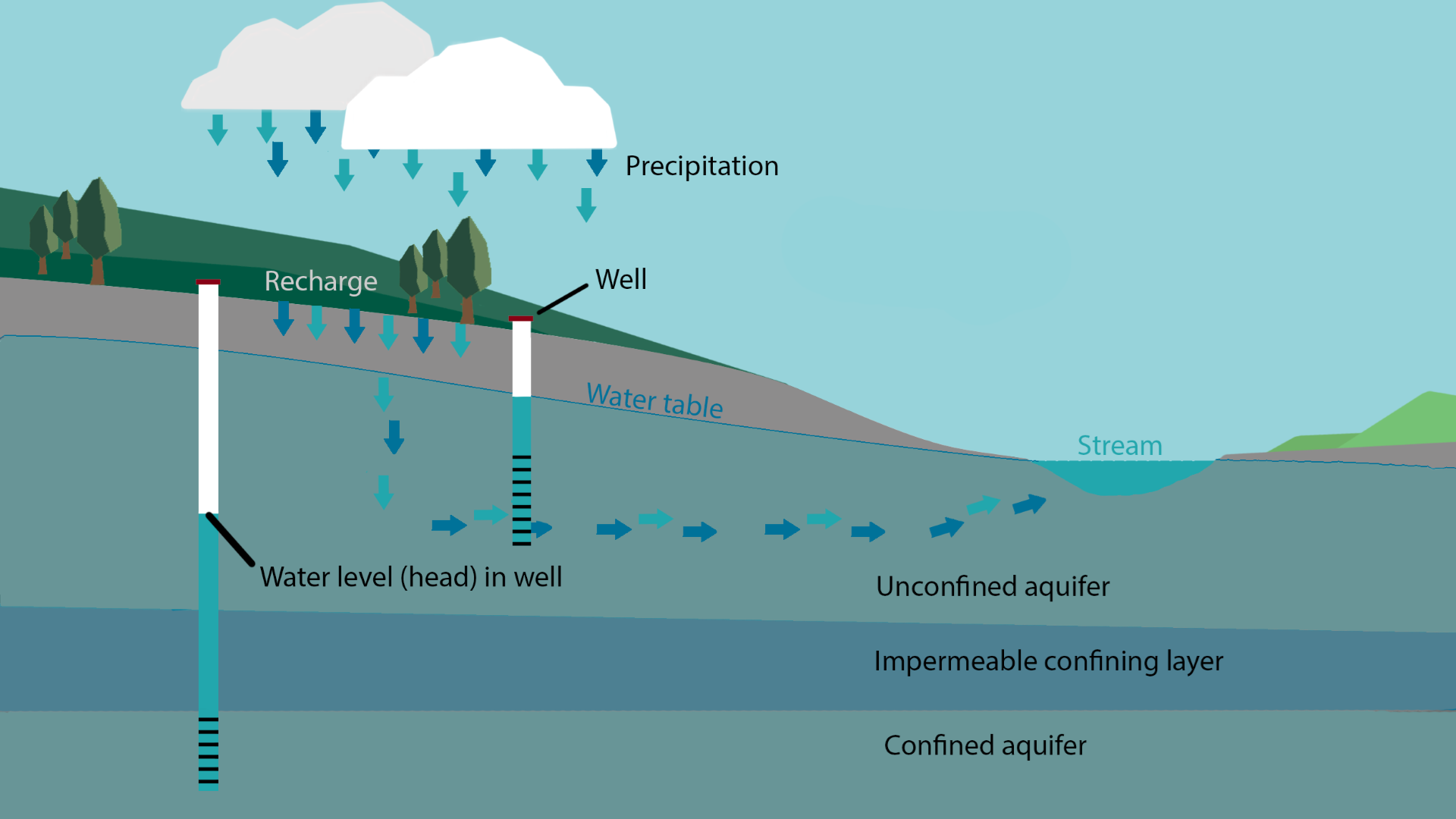What is groundwater?
Groundwater is water found beneath the ground surface. If you dig a hole in the ground, you’ll reach a point where water starts to seep into the bottom of the hole. That’s groundwater. If you pump the water out of the hole, more water seeps in to replace it. You’ve dug a well. Where does the water come from? How did it get there?
When it rains, some of the rain water soaks into the soil and percolates downward into the ground. It fills cracks in rocks and pore spaces between grains of sand and gravel until the ground is saturated, creating an underground body of water that we call an aquifer (Figure 1). There are vast quantities of water in aquifers beneath the ground surface, slowly flowing and seeping through all those cracks and pore spaces. When we dig or drill a well, we can intercept some of that water and pump it out of the ground to use for drinking water supply or irrigation.

Figure 1. Groundwater schematic adapted from United States Geological Survey (public domain, 2019).
Wells
To extract groundwater from an aquifer, we construct a well, which is essentially a hole in the ground that is deep enough to penetrate the saturated zone. Most modern wells are constructed by drilling a hole and lining it with a steel casing to prevent the hole from collapsing. Near the bottom of the well, a screen is attached to the casing to allow water to flow into the well while keeping the rock and sediment out. More information on how wells are constructed can be found in this factsheet.
Types of aquifer
Aquifers can be highly variable in composition. Much of the groundwater used in New Zealand comes from aquifers in unconsolidated sediments - sand and gravel where the individual grains are not cemented together to form solid rock. The groundwater in these aquifers flows through the interconnected pore spaces between grains of sand and gravel. In some areas, particularly in the North Island, the groundwater flows through interconnected cracks in fractured volcanic rocks such as basalt. Some areas have limestone aquifers, where the groundwater flows through cracks that can grow very large as the groundwater dissolves the limestone.
We also talk about aquifers as being confined or unconfined. An unconfined aquifer is like the one pictured in Figure 1. Recharge water percolates straight downward into the aquifer, and the water table, the top of the saturated zone, is the top of the aquifer. In some cases, however, the aquifer can extend into an area where layers of impermeable material prevent direct recharge from the ground surface. This is shown in Figure 2. The water becomes trapped or confined beneath the impermeable layer, and we call it a confined aquifer. The top of a confined aquifer is the base of the impermeable confining layer above it.
Figure 2. Aquifer schematic adapted from Sonoma Valley Groundwater Organization, 2018.
When a well is drilled into an unconfined aquifer, the water in the well rises to the level of the water table. In a confined aquifer, the groundwater is under more pressure. When a well is drilled into a confined aquifer, the water rises higher than the top of the aquifer (the base of the impermeable confining layer). In some cases, the pressure may drive the water completely out of the well. This is called a flowing artesian well (Figure 3).
![]()
Figure 3. Flowing artesian well.
Groundwater flow
The water in an aquifer does not stay still. It flows through the aquifer from the recharge area (the area where water seeps into the aquifer) to the discharge area (an area where groundwater emerges back onto the ground surface as springs or seeps in lakes and rivers). In Figure 2, for example, the recharge area is the wooded area on the left. Rain water percolates into the ground through the forest floor down to the saturated zone (the aquifer). Once there, it flows toward the right and emerges again to feed the surface water on the right side of the picture.
For the most part, groundwater flows much more slowly than rivers and streams, commonly less than a metre per day. In some parts of New Zealand, however, flow rates of tens or even hundreds of metres per day have been measured.
How is groundwater connected to surface water?
Groundwater and surface water (streams, rivers and lakes) are both part of the water cycle, and they are closely linked. They interact in three basic ways, as shown in Figure 4:
- Gaining stream - a stream can gain groundwater if the elevation of the water table in the vicinity of the stream is higher than the stream water surface.
- Losing stream - a stream can lose water to groundwater if the water table is below the elevation of the stream-water surface. In areas where the water table has large variations during the year, a stream segment could receive water from groundwater for a portion of the year and lose water to groundwater at other times.
- Losing stream disconnected from groundwater source - where the water table is much lower than the stream, the losing stream will lose water to the unsaturated zone, and the level of the groundwater does not directly affect the flow in the stream.
The movement of water between groundwater and surface water systems leads to the mixing of their water qualities. High quantities of nutrients or other dissolved chemicals in surface water can be transferred to the connected groundwater system and vice versa.

Figure 4. Groundwater and surface water interaction schematic.
What affects groundwater quality?
Groundwater dissolves salts and other substances from the soils and rocks that it flows through. The quality of the groundwater, therefore, is dependent largely on the aquifer material. For example, groundwater in a limestone aquifer can contain high concentrations of dissolved calcium carbonate, making it hard. Similarly, groundwater in a volcanic aquifer may contain a variety of salts dissolved from the volcanic rock. In contrast, groundwater in many of the alluvial gravel aquifers in New Zealand have low concentrations of dissolved salts because the aquifer sediments are dominated by insoluble greywacke gravels.
Groundwater quality is also affected by human activities. In agricultural areas, water percolating through the soil can dissolve or leach fertilisers (particularly nitrate) and pesticides and carry them downward into the underlying aquifer. Grazing animals, wastewater discharges and on-site wastewater systems (septic systems) provide pathogenic micro-organisms (bacteria and viruses) that can also be carried through the soil into the groundwater. Improper waste disposal or leaking pipes and storage tanks can also cause groundwater contamination in urban and industrial areas.
Redox conditions
A concept that is important for nitrate contamination, as well as contamination by heavy metals, is referred to as “redox”, or reduction–oxidation reactions. Some aquifers contain organic material or vegetable matter, particularly swampy areas or areas that have been swamps in the geologic past. The organic material breaks down or rots over time, consuming all the available oxygen. We call these conditions “reducing”.
Under such reducing conditions, even the oxygen in the nitrate molecule is consumed, and the nitrate is converted to nitrogen gas. Therefore, nitrate concentrations are very low in groundwater with reducing conditions. On the other hand, some metals are more soluble under reducing conditions, so even though the nitrate concentrations may be low, the groundwater may contain dissolved metals such as iron, manganese and arsenic.
In many alluvial aquifers in New Zealand, such as the Canterbury Plains, the aquifer sediments contain little or no organic material, and the groundwater remains well oxidised even to great depths below the ground surface. In such areas, nitrate can persist for many decades and travel long distances.

